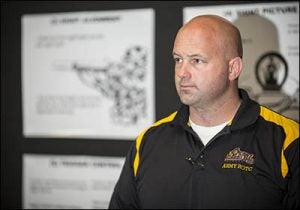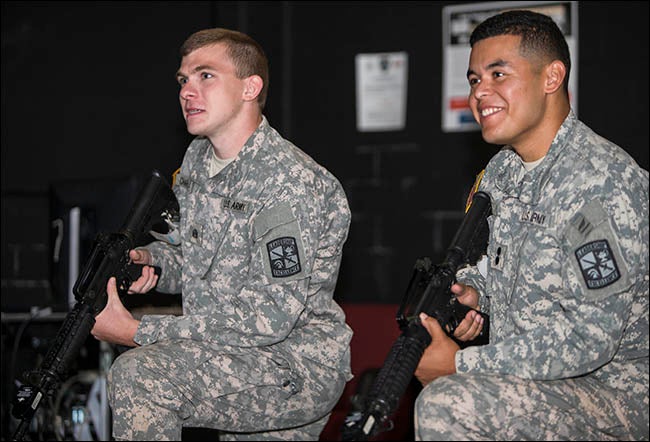IN THEIR SIGHTS
Simulator tests cadets’ shooting, decision-making skills
Some East Carolina University students headed for military service are honing their marksmanship and decision-making skills at a simulated firing range on campus.
The simulator is one of approximately 11 on college campuses nationwide. Located in Christenbury Memorial Gymnasium, the home of ECU’s Army and Air Force Reserve Officer Training Corps units, the training tool is used by about 150 cadets each academic year. A flight simulator also is located in Christenbury.
“It creates a semi-real environment and it can put them in scenarios they may see (in the field),” said Master Sgt. Clint D. MacMiller, senior military instructor with ECU’s Army ROTC. “There are a lot of different scenarios we can run on this.” Some are even classified and off-limits for students.
Cadets learn to use 9 mm pistols or M-4 carbine rifles at the simulated firing range, which resembles a typical military or civilian facility. No machine gun systems are used.
The weapons work with air compressors and lasers that aim at targets projected on a large screen. The rectangular-shaped room is painted black, and students lie or stand on an artificial turf-covered platform to practice. Magazines are weighted and can carry about 30 rounds of ammunition. Instructors program in the number of bullets each participant has, and cadets can even wear body armor.
“You get all this data which helps you to see what they’re doing well and what they’re doing wrong,” MacMiller said. “It definitely helps us determine where we need to work with that individual” on techniques such as body position or trigger squeeze.Data is stored in the computer so when cadets return for another training session they can compare results.
Recently, a “shoot, don’t shoot” scenario unfolded before rising ECU seniors Andres Barrera and Joshua Charlton. The cadets were guarding a roadside checkpoint in the simulation when someone opened fire.

Master Sgt. Clint D. MacMiller, senior military instructor for ECU Army ROTC, observes ECU cadets as they train using the simulator.
“The person at the computer can have it escalate or de-escalate depending on the situation,” MacMiller said. “We can program in a weapon malfunction. They have to learn to work their weapons very quickly.”
In the end, Charlton delivered a lethal hit to the assailant’s chest. Each cadet received information on the number of shots taken and missed, lethal and non-lethal hits and exactly where they fired.
Barrera said it’s some of the most beneficial training he can get. “The rifle is really an extension of us in a way,” he said.
Charlton said the different scenarios help with situational awareness on and off campus. “You think twice, you react faster, it’s a mental discipline thing,” he said.
Barrera, of Charlotte, is majoring in Spanish and political science and hopes to enter active duty after graduation. He initially joined the North Carolina Army National Guard his sophomore year for college benefits. “For the first time in a long time, I felt like I was doing something productive,” he said.
An athlete in high school, Barrera said his commitment reinforces goal setting and self-discipline. “I like the camaraderie,” he said.
Charlton, of Tyner, said he has always wanted to be in the Army. “I want to better myself and my leadership skills and I want to travel,” he said. A criminal justice major, Charlton is considering a career as a military police officer.
MacMiller said ECU is fortunate to have a facility like the simulated firing range. “ECU has been very good to us and supportive of military programs,” said MacMiller, who served three combat deployments in Iraq and Afghanistan. “It definitely benefits the cadre.”
ECU, geographically, sits in the center of the third most concentrated military corridor in the country. Craven, Cumberland, Onslow and Wayne counties are home to six major military installations, the biggest being Fort Bragg and Camp Lejeune.
In 2010, ECU received the U.S. Secretary of Defense Freedom Award in recognition of its support of the guard and reserve.
ECU’s Air Force and Army ROTC programs are in the departments of aerospace studies and military science in the College of Health and Human Performance. For more information, visit www.ecu.edu/hhp.

Cadets Charlton and Barrera relax following a simulation activity in which they were required to respond quickly to a rapidly developing hostile situation.
